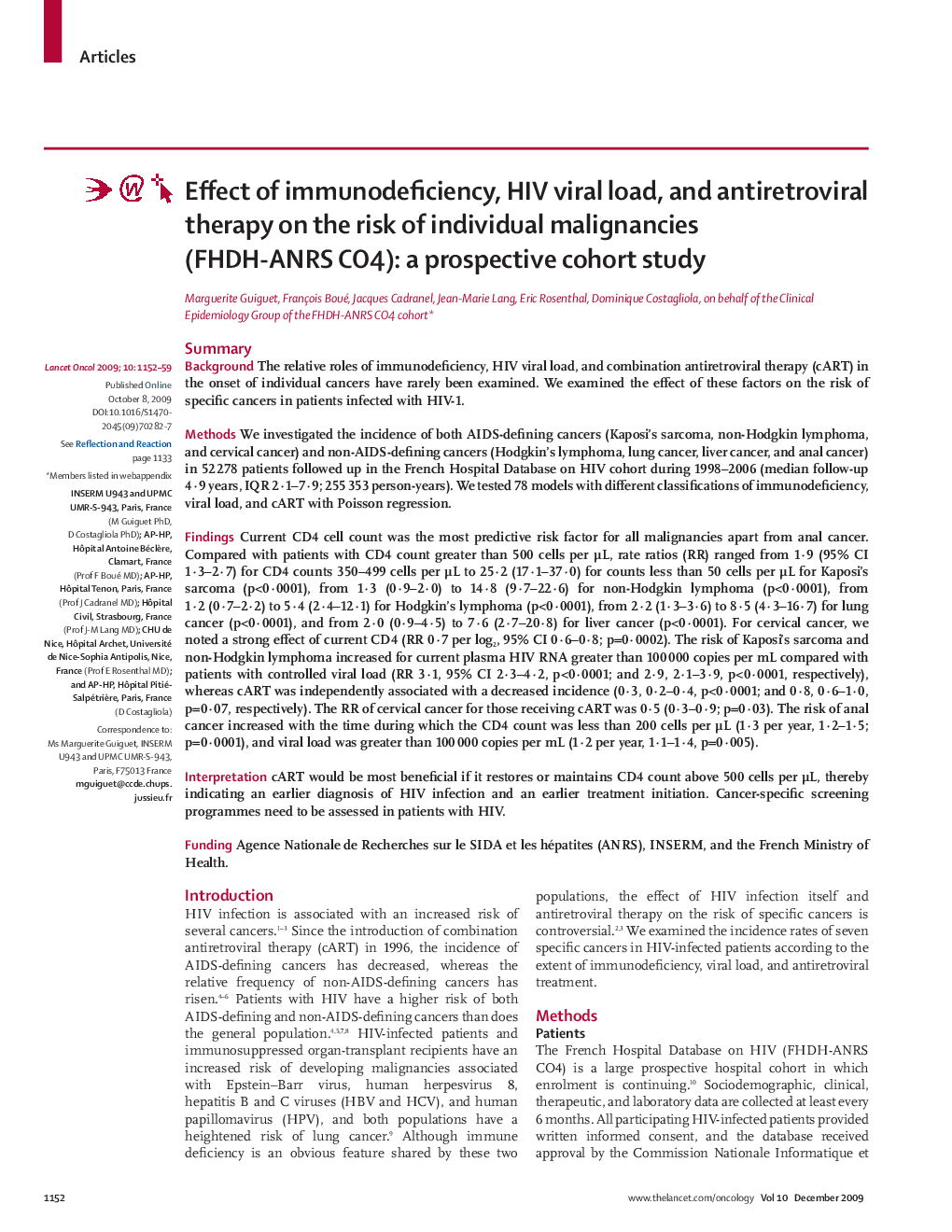| کد مقاله | کد نشریه | سال انتشار | مقاله انگلیسی | نسخه تمام متن |
|---|---|---|---|---|
| 3994589 | 1601664 | 2009 | 8 صفحه PDF | دانلود رایگان |

SummaryBackgroundThe relative roles of immunodeficiency, HIV viral load, and combination antiretroviral therapy (cART) in the onset of individual cancers have rarely been examined. We examined the effect of these factors on the risk of specific cancers in patients infected with HIV-1.MethodsWe investigated the incidence of both AIDS-defining cancers (Kaposi's sarcoma, non-Hodgkin lymphoma, and cervical cancer) and non-AIDS-defining cancers (Hodgkin's lymphoma, lung cancer, liver cancer, and anal cancer) in 52 278 patients followed up in the French Hospital Database on HIV cohort during 1998–2006 (median follow-up 4·9 years, IQR 2·1–7·9; 255 353 person-years). We tested 78 models with different classifications of immunodeficiency, viral load, and cART with Poisson regression.FindingsCurrent CD4 cell count was the most predictive risk factor for all malignancies apart from anal cancer. Compared with patients with CD4 count greater than 500 cells per μL, rate ratios (RR) ranged from 1·9 (95% CI 1·3–2·7) for CD4 counts 350–499 cells per μL to 25·2 (17·1–37·0) for counts less than 50 cells per μL for Kaposi's sarcoma (p<0·0001), from 1·3 (0·9–2·0) to 14·8 (9·7–22·6) for non-Hodgkin lymphoma (p<0·0001), from 1·2 (0·7–2·2) to 5·4 (2·4–12·1) for Hodgkin's lymphoma (p<0·0001), from 2·2 (1·3–3·6) to 8·5 (4·3–16·7) for lung cancer (p<0·0001), and from 2·0 (0·9–4·5) to 7·6 (2·7–20·8) for liver cancer (p<0·0001). For cervical cancer, we noted a strong effect of current CD4 (RR 0·7 per log2, 95% CI 0·6–0·8; p=0·0002). The risk of Kaposi's sarcoma and non-Hodgkin lymphoma increased for current plasma HIV RNA greater than 100 000 copies per mL compared with patients with controlled viral load (RR 3·1, 95% CI 2·3–4·2, p<0·0001; and 2·9, 2·1–3·9, p<0·0001, respectively), whereas cART was independently associated with a decreased incidence (0·3, 0·2–0·4, p<0·0001; and 0·8, 0·6–1·0, p=0·07, respectively). The RR of cervical cancer for those receiving cART was 0·5 (0·3–0·9; p=0·03). The risk of anal cancer increased with the time during which the CD4 count was less than 200 cells per μL (1·3 per year, 1·2–1·5; p=0·0001), and viral load was greater than 100 000 copies per mL (1·2 per year, 1·1–1·4, p=0·005).InterpretationcART would be most beneficial if it restores or maintains CD4 count above 500 cells per μL, thereby indicating an earlier diagnosis of HIV infection and an earlier treatment initiation. Cancer-specific screening programmes need to be assessed in patients with HIV.FundingAgence Nationale de Recherches sur le SIDA et les hépatites (ANRS), INSERM, and the French Ministry of Health.
Journal: - Volume 10, Issue 12, December 2009, Pages 1152–1159